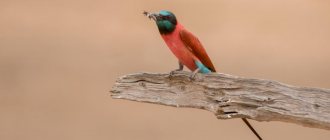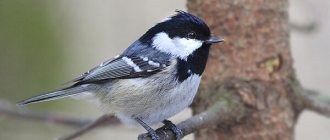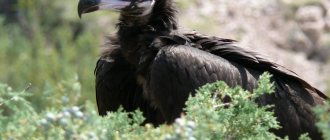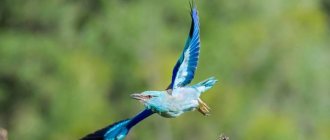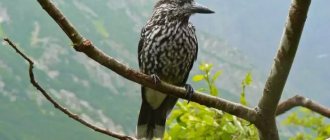- Wild animals
- >>
- Birds
The peregrine falcon is the most common species among birds of prey. It is the size of an ordinary crow. A representative of the falcon family is rightfully considered the fastest creature living on the planet. Excellent hunters, with excellent vision and lightning-fast reactions, do not leave their prey a single chance of salvation.
Origin of the species and description
Photo: Sapsan
The English scientist Marmaduke Tunstell first described the species in 1771 and gave it the name Falco peregrinus. Its first part is translated as “sickle-curved” due to the shape of the bird’s wings during flight. Peregrinus means "wanderer", which refers to the peregrine falcon's lifestyle.
Video: Peregrine falcon bird
Close relatives include the gyrfalcon, laggar, saker falcon, Mediterranean and Mexican falcons. Often these birds are combined into one group. Ornithologists believe that the evolutionary divergence of these species from the rest occurred during the Miocene or Pliocene periods, approximately 5-8 million years ago.
The center of divergence most likely was Western Eurasia or Africa, since the group contains species from both the Old and New Worlds. Due to hybridization between species, scientific research on this group is difficult. For example, in home breeding conditions, crossing peregrine falcons with Mediterranean falcons is popular.
There are about 17 subspecies of predators in the world, formed due to their territorial location:
- tundra falcon;
- Maltese falcon;
- black falcon;
- Falco peregrinus japonensis Gmelin;
- Falco peregrinus pelegrinoides;
- Falco peregrinus peregrinator Sundevall;
- Falco peregrinus minor Bonaparte;
- Falco peregrinus madens Ripley Watson;
- Falco peregrinus tudrius White;
- Falco peregrinus ernesti Sharpe;
- Falco peregrinus cassini Sharpe and others.
Interesting fact: Since ancient times, peregrine falcons have been used for falconry. During excavations in Assyria, a bas-relief was found dating back to around 700 BC, where one of the hunters launched a bird, and the second caught it. Birds were used for hunting by Mongolian nomads, Persians, and Chinese emperors.
Appearance and features
Photo: Peregrine falcon bird
The peregrine falcon is a relatively large predator. Its body length is 35-50 centimeters, its wingspan is 75-120 centimeters. Females are significantly heavier than males. If a male individual weighs about 440-750 grams, then a female individual weighs about 900-1500 grams. The coloring of females and males is the same.
The physique, like that of other active predators, is powerful. The broad chest has massive, hard muscles. The strong paws have sharp, curved claws that easily rip the skin of prey at high speed. The upper body and wings are gray with dark stripes. The wings are black at the ends. The beak is curved.
Interesting fact: At the tip of the beak, birds have sharp teeth, allowing them to easily bite the cervical vertebrae of their prey.
The plumage on the abdomen is usually light in color. Depending on its habitat, it may have a pinkish tint, red, or gray-white. There are droplet-shaped streaks on the chest. The tail is long, rounded, with a small white stripe at the end. The upper part of the head is black, the lower part is light, reddish.
Brown eyes are surrounded by a strip of bare skin with a yellowish tint. Legs and beak are black. Young peregrine falcons have a less contrasting color - brown with a light lower part and longitudinal streaks. The voice is shrill and harsh. During the breeding season they scream loudly, the rest of the time they are usually silent.
Now you know everything about the appearance of the rare bird peregrine falcon from the Red Book. Let's see where the fast predator lives and what it eats.
Description of the bird
The peregrine falcon is a large falcon with a body length of 34 to 50 cm, a wingspan of 80 to 120 cm. Females are larger than males: their weight is from 910 to 1500 g, and males are usually a third less, their weight is from 440 to 750 g. The plumage color of males and females is the same.
— Advertising —
The bird is distinguished by its robust build with a broad chest, strong fingers with sharp curved claws, and a short, sickle-shaped beak. The plumage of adult birds on the back, wings and rump is slate-gray, with dark transverse stripes. The tips of the wings are painted black. The belly is light: from grayish-white, pinkish to reddish or ocher tones, with brown or black thin transverse streaks. The breast is decorated with teardrop-shaped streaks. The tail is long and narrow, rounded at the end. The bottom of the tail is black with a white edge. The head is black on top, black “whiskers” stretch from the corner of the beak to the throat, the throat is light, white or reddish. The eyes are large, dark brown, with a yellow eye ring. The cere is yellow, the beak and paws are black. At the end of the beak there are teeth designed to bite the spine of the victim.
Juveniles have contrasting plumage. They have a brown back with buffy edges of coverts, a light belly with longitudinal streaks. The cere is bluish-gray, the paws are yellow.
Where does the peregrine bird live?
Photo: Peregrine falcon from the Red Book
The species is distributed on all continents except Antarctica, including many islands. Easily adapts to any environment. It can live both in cold tundras and in hot Africa and Southeast Asia. At different times of the year, you can meet birds in almost every corner of the world, with the exception of deserts and polar regions. Peregrine falcons are not found in most tropical rainforests.
Individuals do not like open spaces, so they avoid the steppes of Eurasia and South America. In mountainous areas it can be found at an altitude of up to 4 thousand meters above sea level. Such distribution allows falcons to be considered the most common predators in the world.
Birds choose habitats that are inaccessible to people. Usually these are rocky shores of reservoirs. The best conditions for nesting are mountain river valleys. In the forests they inhabit places near river cliffs, moss swamps, and tall trees. They can live in the nests of other birds. A prerequisite for residence is a body of water with an area of at least 10 square kilometers.
Interesting fact: A family of peregrine falcons lives on the balcony of a skyscraper in Atlanta above the 50th floor. Thanks to the installed video camera, their life and development can be observed in real time.
Birds lead a sedentary lifestyle. With the onset of cold weather they can travel short distances. Sexually mature males try not to leave the nesting territory even in the cold season. In the Arctic and subarctic zones, migrations over long distances can take place.
Interesting Facts
In the USA, there are web cameras on the balcony of a skyscraper, with the help of which anyone can observe the life of peregrine falcons nesting above the 50th floor. There is also only one pair of peregrine falcons living in Moscow, though so far; they have settled on the main building of Moscow State University.
The peregrine falcon has become the symbol of the US state of Idaho, and its image is depicted on a commemorative 25-cent coin printed by the mint in 2007. On Russian flags and coats of arms there is an image of a peregrine falcon: Suzdal, Sokol, Kumertau, it was the family sign of the ancient Russian princes.
Circling over the fields looking for prey, the birds fly at low speed; even a swift can outrun the famous hunter. But only a keen eye caught the movement of the prey; its behavior changes dramatically, a swift, deadly dive, the main trump card of a fearless hunter.
Interestingly, developing above sound speed, the bird does not experience a lack of air; this is facilitated by the special structure of the nasal septum. The air movement slows down and the bird continues to breathe as usual.
In 1530, the island of Malta was transferred by Emperor Charles 5 to the knightly order. Mandatory condition of the emperor: one peregrine falcon, every year as a gift. After this story, a new subspecies appeared - the Maltese.
What does the peregrine falcon eat?
Photo: Fast bird peregrine falcon
The basis of the diet of birds includes small and medium-sized birds, depending on their place of residence:
- pigeons;
- sparrows;
- hummingbird;
- ducks;
- seagulls;
- starlings;
- blackbirds;
- waders.
Interesting fact: Scientists made a calculation and found that approximately 1/5 of all existing birds come from falcon food.
They will not fail to catch a rodent, small mammal or amphibian if they are gaping in the open:
- frogs;
- lizards;
- protein;
- bats;
- hares;
- gophers;
- voles;
- insects
Peregrine falcons give preference only to the body of the victim. Legs, heads and wings are not eaten. Ornithologists have noticed that the remains of birds are always scattered around the nests of birds. It is from them that scientists find out what the owners of the home eat.
During the period of caring for chicks, predators can hunt smaller prey, and sometimes they are not afraid to encroach on victims larger than themselves. The weight of a heron or goose is several times that of a peregrine falcon, but this does not prevent hunters from killing their prey. Falcons do not attack larger animals.
Young animals that cannot fly or injured birds can pick up food from the ground, but hunting in the air attracts them much more. When flying horizontally, the speed of peregrine falcons is not that high - 100-110 km/h. Pigeons or swallows can easily dodge them. But with a rapid dive, there is no chance of salvation for any of the victims.
FOOD AND HUNTING
The peregrine falcon feeds mainly on birds. In winter, these birds inhabit areas around river mouths and hunt mainly gulls and ducks. The peregrine falcon catches most of its victims in the air. Noticing the prey, it makes a sharp acceleration and, in a diving flight, rushes at the prey, grabbing it by the neck, crushing the cervical vertebrae. With small prey he flies to the nest, and kills large birds in the air and lowers them to the ground. The peregrine falcon eats about 100 g of food per day. During the period of raising and feeding the chicks, its needs increase. The falcon's hunting territory ranges from 40 to 200 km2. Peregrine falcons very rarely hunt mammals, however, even rabbits sometimes become their victims.
Features of character and lifestyle
Photo: Peregrine falcon bird of prey
Predators prefer a solitary lifestyle, keeping in pairs only during the nesting period. They guard their territories very fiercely, driving away not only their relatives, but also other large predators. Together, a couple can drive away a small four-legged animal from the nest. A mother protecting her chicks can scare away even a large one.
The nests are located at a distance of 5-10 kilometers from each other. Falcons prefer not to hunt near their homes, so other birds tend to position themselves as close as possible to the nests of peregrine falcons. This makes it possible to be protected not only from the falcon, but also from other predators that they drive away.
Birds go hunting in the morning or evening. If there is no one in the air whom they could catch, the falcons sit on a high tree and can watch the space for hours. If hunger is too strong, they fly above the surface of the earth to scare away potential prey, and then grab it.
If a prey is visible in the sky, predators try to quickly gain altitude in order to catch it in a lightning-fast dive. Their diving flight speed is about 322 km/h. At this speed, a blow from the rear toes is enough to cause the victim's head to fly off.
Thanks to fearlessness, good trainability and intelligence, they become unsurpassed hunters. People often use raptors in falconry. A trained bird costs a lot of money, but at the same time it becomes an invaluable assistant for humans.
Lifestyle and habitat
The peregrine falcon is a cunning and unpretentious predator that successfully takes root all over the globe, except Antarctica and New Zealand. He is not afraid of high arctic frosts and intense heat of the African tropics.
Avoids extremely cold polar regions, mountain ranges above 4 thousand meters, deserts, tropics with excess moisture and large steppes. In Russia, there are no nesting sites only in the Volga steppes and Western Siberia.
Prefers rocky shores of various bodies of water. The nesting site is chosen that is difficult to reach for natural enemies (including humans), always with good visibility and areas for free approach.
The most suitable nesting conditions are found in mountain river valleys; rocky shores and the presence of a reservoir provide the highest population density. In the mountains it settles on rocky ledges, in the forest it chooses the tallest trees, on the sides of river cliffs, in moss swamps, and happily takes over the nests of other birds.
Sometimes a peregrine falcon's nest can be seen in big cities, on the roofs of high-rise stone buildings. Chimneys of various factories, bridges, high bell towers, niches of high-rise buildings, in general, anything that somehow resembles natural rocky ledges are also a good place for a nest.
The majority of birds lead a sedentary lifestyle, with the exception of populations living in the difficult conditions of the Far North; they fly to warmer areas for wintering. Sometimes, more often in cold weather, they can move several kilometers in search of better food supply.
The length of the territory of one nest ranges from 2 to 6 kilometers. This is necessary to provide the required amount of feed, the urgent need for which increases significantly during the period of feeding the offspring. Each pair has 6-7 places suitable for laying eggs; they are used for more than one season.
Birds fiercely guard their hunting grounds; when invading their domains, they even attack individuals that are significantly larger in size (eagles, crows). The approach of a person is sensed from a distance of 200-300 meters and an alarm is sounded.
If the intruder continues to move towards the nest, the male, screaming loudly, begins to circle overhead, periodically sitting down on trees growing nearby, the female joins him. A peregrine falcon guarding a nest with chicks becomes quite aggressive and can expel quite large mammals from its territory: dogs, foxes, arctic foxes.
The peregrine falcon feeds mainly on much smaller birds: sparrows, thrushes, starlings, ducks, and pigeons. Sometimes its victims include: bats, squirrels, hares, and waterfowl. Like a real predator, he destroys other people's nests.
The diversity of food depends on the habitat; for example, the barnacle falcon hunts mainly on ground squirrels, lemmings and voles, which are common in its feeding territory. They make up at least 30% of the total production.
Hunting takes place in the morning or evening hours. The peregrine falcon most often sits in ambush high on a ledge, waiting for prey to appear. It can fly close to the ground, trying to scare away lurking prey and drive it out of hiding.
Seeing the prey, the bird rises high into the sky, folding its wings, dives sharply down, almost at a right angle, goes into a steep dive, trying to hit the victim with its strong paws. Peregrine falcons sometimes hunt in pairs. Trying to catch prey in the air on the fly or on approach, alternately diving after the victim.
Circling over the fields looking for prey, the birds fly at low speed; even a swift can outrun the famous hunter. But only a keen eye caught the movement of the victim; his behavior changes dramatically, a swift, deadly dive, the main trump card of a fearless hunter.
When diving, the peregrine falcon's speed sometimes increases to 322 km/h, making it the fastest bird in the world. The blow of his paws is so strong that the victim often loses his head. Any prey that accidentally survives such a powerful attack will be finished off with a powerful beak equipped with a hook. They dine on elevated places with good visibility.
They eat their prey selectively, leaving the head, wings, legs intact, which is how they differ from other feathered predators. Around the nesting site you can find food remains, which scientists ornithologists use to determine the bird’s diet. Also, based on the presence of characteristic remains, it is possible to unmistakably determine whether the nest belongs to a peregrine falcon or another predator.
Social structure and reproduction
Photo: Rare bird peregrine falcon
Sexual maturity of both sexes occurs one year after birth. But they begin to reproduce only after reaching two or three years of age. Falcons choose a pair for many years. Families are attached to one nesting territory; several generations can live in one area.
The breeding season begins in May-June, later in the northern range. The male attracts the female with aerial pirouettes. If the chosen one lands not far from this place, it means that the couple is formed. Partners look at each other, clean their feathers or claws.
During the courtship period, the male can feed his partner, passing food to her in flight. The female rolls over onto her back and catches the gift. During the nesting process, the pair is very aggressive towards intruders. There can be up to 7 nests in one territory. In different seasons, peregrine falcons use different places.
Eggs are laid from April to May, once a year. Females lay from two to five reddish or brown eggs, usually three - every 48 hours, an egg measuring 50x40 mm. For 33-35 days, both partners incubate the offspring. Newborn chicks are covered with grayish down, have large paws and are absolutely helpless.
The female takes care of the offspring most of the time while the father gets food. The first flight of the chicks takes place at the age of 36-45 days, after which the babies remain in the parent’s nest for several more weeks and depend on the food obtained by the father.
Nesting
Tall trees, rocks, buildings are the main places for arranging nests. It is very rare to see a peregrine falcon nest on the ground. The main condition for building a nest is that it is inaccessible to enemies and the space around it is clearly visible.
Birds are ready to form a pair and reproduce after reaching one year, but more often mating occurs at the age of 2-3 years.
Interesting! Peregrine falcons are monogamous and mate for life.
They are staunch adherents of the territorial factor. Entire dynasties of birds can live in one area. Despite the large population, the distance between nests remains within 2-6 kilometers. When choosing a nesting site, the peregrine falcon prefers an area with a waterway. It could be a lake, a mountain river, a small stream, but it must be there.
The peregrine falcon has been used as a bird of prey since ancient times. In the modern world, the passion for hunting with a falcon has not gone away, but keeping the bird is expensive and requires compliance with special rules
Natural enemies of peregrine falcons
Photo: Sapsan
For adults, no bird of prey poses a significant threat, since falcons are at the top of the food chain. However, their eggs or young chicks can be harmed by other large birds - eagle owls, kites, eagles. Ground nests can be destroyed by martens, foxes and other mammals.
The birds are not timid and in most cases can stand up for themselves, attacking birds much larger than themselves and large animals. They will not be afraid to drive away a person either - the peregrine falcons will constantly circle over the person who disturbed their peace.
People have always been fascinated by the skills of birds. They tried to tame the flyers and use them for personal purposes. Peregrine falcons were caught as chicks and trained to catch other birds. Kings, princes, and sultans possessed birds of prey. Falconry was popular in the Middle Ages. The spectacle is truly breathtaking, so peregrine falcons were highly valued, tribute and taxes were paid with them.
The most dangerous enemy for a bird is man. Due to the expansion of agricultural land, chemicals and pesticides are constantly used to kill pests. However, poisons not only kill parasites, they are also fatal to birds that feed on pests. Humans are destroying large areas of the natural habitats of predators.
Peregrine Falcon, Golden Eagle, Kestrel are birds of prey: why are they protected?
Many animals, fish and birds are listed in the Red Book. This means that they are protected by law and it is prohibited to catch such animals. Birds of prey such as the Peregrine Falcon, Golden Eagle and Kestrel are also protected. Why? Here is the answer:
- Birds of prey hunt rodents, which cause a lot of harm to humans, so it was decided to protect them.
In addition, such birds are very beautiful and poachers catch them for sale. This is prohibited by law and such people can be punished with even a large fine or imprisonment.
Population and species status
Photo: Peregrine falcon bird
Despite its good adaptability to any climatic and landscape conditions, the peregrine falcon has always been considered a rare bird. In general, the population is considered stable at the present time, but in some regions the number may fluctuate or decline to complete disappearance from its usual habitats.
In the second half of the 20th century, the population suffered significant losses due to the massive use of pesticides and DDT. Pesticides tended to accumulate in the body of birds and affect the embryonic development of chicks. The eggshells became too fragile and could not support the weight of the birds. The reproduction rate of offspring has decreased sharply.
Between 1940 and 1960, the birds completely disappeared from the eastern part of America, and in the west the population declined by 75-90%. In Western Europe, peregrine falcons have also practically ceased to be seen. In 1970, the use of pesticides was banned and the number began to gradually increase. At the moment there are about 2-3 thousand pairs in Russia.
Fun Fact: During World War II, military personnel killed peregrine falcons to prevent them from intercepting and eating carrier pigeons.
Although the shooting and enslavement of birds are a thing of the past, the numbers are increasingly affected by food competition with the balaban falcon, the destruction of natural nesting sites, and poaching. Predators can easily get along with people living in the neighborhood, but are too sensitive to disturbance caused by people.
GENERAL INFORMATION
Sung in Ukrainian and Russian songs, the real falcon, which is often also called the “peregrine falcon,” lives in many regions of the globe. It can be found from the polar cliffs of Scandinavia and Taimyr in the north to the fjords of Tierra del Fuego in the south. Falcons make nests on the ledges of cliffs or in abandoned nests of ravens and eagles. They feed mainly on birds (waders, crows, gulls, mallards and ducks, less often - geese), which they catch on the fly. In pursuit of prey, a peregrine falcon can reach enormous speeds during a dive! The maximum recorded speed of a peregrine falcon at its peak is 389 km/h! Not every plane flies at such speed! This record was recorded in 2005.
Human persecution and the excessive use of pesticides in agriculture have led to the fact that this beautiful bird has become rare or completely disappeared everywhere. Only the peregrine falcons of the Arctic were lucky. In the North, the falcon is called the goose shepherd, and for good reason: wild geese willingly settle next to its nests. After all, on earth it doesn’t hurt anyone. But in the sky no one can withstand the insane attacks of falcons!


